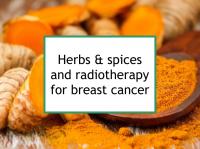The current webpage is designed to make additional research available concerning how certain culinary herbs and spices can enhance the treatment effects of radiotherapy. These are herbs and spices with significant levels of compounds that act as radiosensitizers. At the bottom of this webpage are links to studies relating to the beneficial herbs and spices listed in Foods to eat and avoid during radiation treatment.
The following herbs and spices or their extracts have been tested and found specifically to enhance the effects of radiotherapy for breast cancer:
Generally speaking, herb and spice consumption heightens the cytotoxic effects of radiotherapy on breast cancer cells without harming normal cells through the actions of certain polyphenols, among them:
- Apigenin (found in celery seed and Mexican oregano, as well as parsley)
- Capsaicin (chili powder, hot sauce)
- Crocin (saffron)
- Curcumin (turmeric)
- Gingerol & 6-shogaol (ginger)
- I3C & DIM (horseradish & wasabi, mustard)
- Kaempferol (saffron)
- Lutein (basil, cilantro, parsley)
- Luteolin (celery seed, oregano, thyme)
- Myricetin (parsley)
- Piperine (black pepper)
- Quercetin (chili powder, hot sauce, Mexican oregano)
- Rosmarinic acid (oregano, rosemary, thyme)
- Sulforaphane (horseradish & wasabi, mustard)
- Thymoquinone (black cumin)
- Ursolic acid (basil, rosemary, thyme)
Please read the applicable food webpages when making your own food lists since these pages contain important advice, food rankings (e.g., highly recommended, recommended in moderation), consumption limits, and other pertinent information.
Herb and spice phytonutrients should be obtained by eating them in food rather than taking supplements. When a beneficial nutrient is administered at low doses by consuming food, it is likely to have subtle chemopreventive effects, whereas the same compound administered at high doses is more likely to have pharmacological effects, with possible unwanted outcomes. For example, quercetin has been reported to contribute to the growth of estrogen-induced mammary tumors once the tumors were established in female rats.
In addition, herbs and spices ought to be consumed in moderation. Most oils and concentrates should be consumed infrequently in modest amounts or avoided (see the relevant food web pages in this website).
